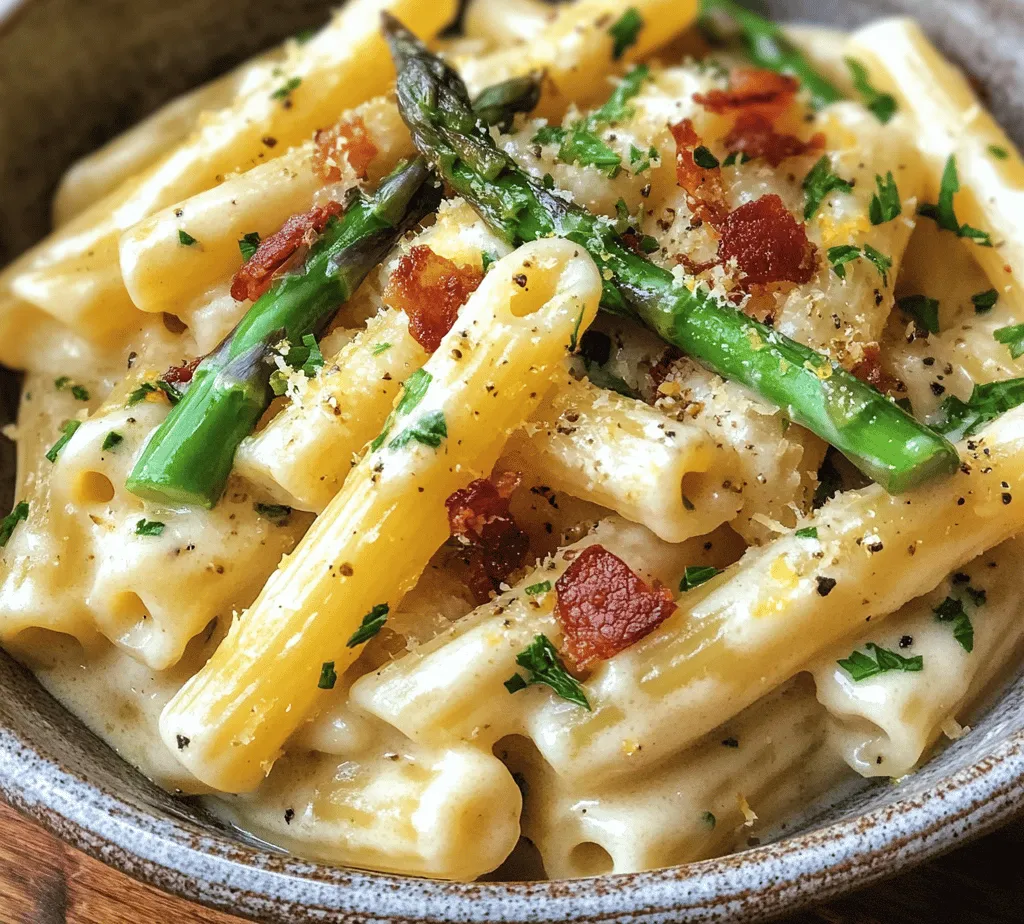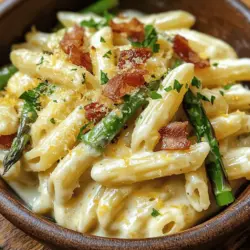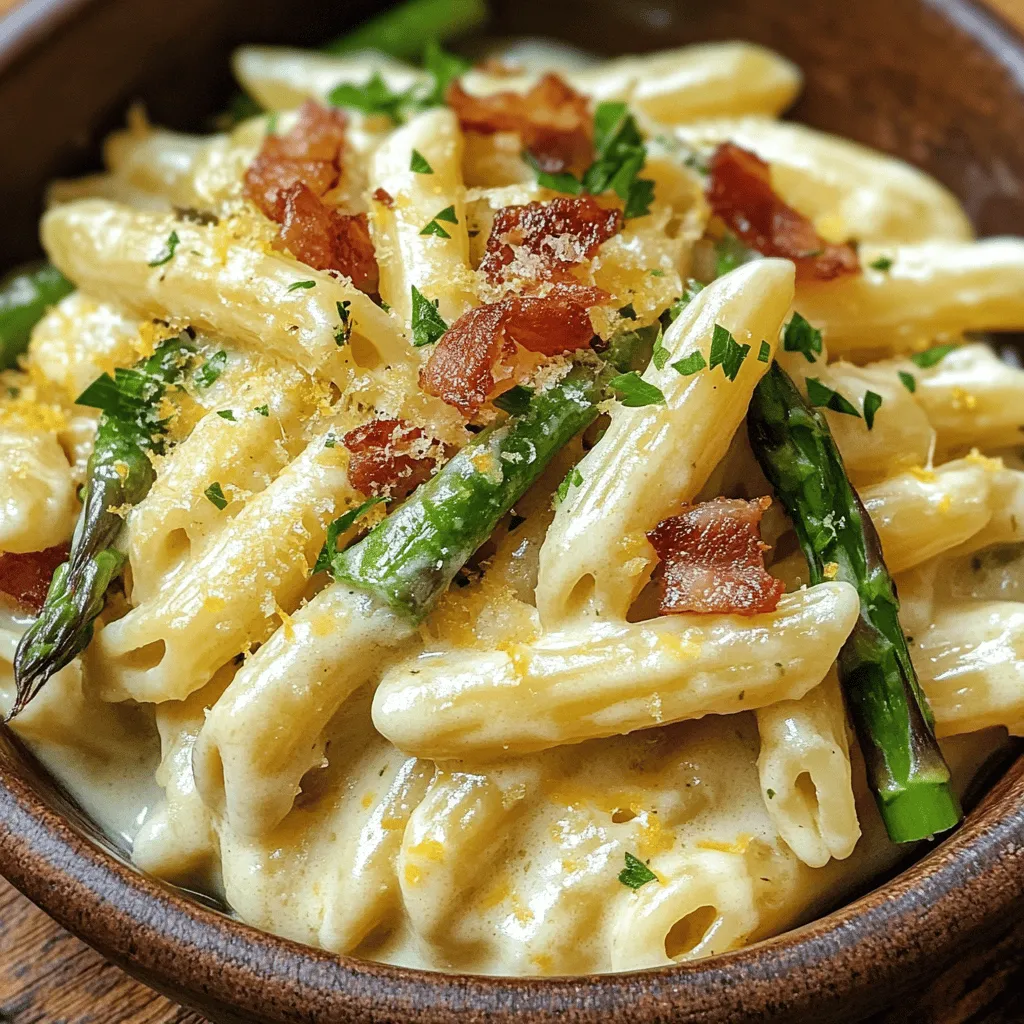Introduction
If you’re looking for a delightful and satisfying pasta dish that combines rich flavors with fresh ingredients, look no further than Pennette with Pancetta and Asparagus. This Italian-inspired recipe uniquely showcases the delicate texture of pennette pasta, the savory depth of pancetta, and the vibrant freshness of asparagus, all enveloped in a creamy, indulgent sauce. Whether you’re preparing a weeknight dinner or entertaining guests, this dish is bound to impress with its sophisticated yet approachable flavors.
The essence of any great pasta dish lies in the quality of its ingredients. Using fresh asparagus and high-quality pancetta enhances the flavors and brings the dish to life. The creamy sauce, accentuated by garlic and Parmesan cheese, complements the distinct elements of the dish, creating a harmonious balance that is both satisfying and comforting.
Let’s dive deeper into the star ingredients that make this recipe a must-try, and then we will explore the preparation steps that will lead you to a beautifully crafted plate of Pennette with Pancetta and Asparagus.
Understanding the Ingredients
Overview of Pennette Pasta
Pennette is a short, tubular pasta that is slightly smaller than penne, which makes it an excellent choice for a variety of sauces. Its unique shape allows it to hold onto sauces effectively, making each bite a delightful experience. The smooth surface of pennette is perfect for creamy sauces, as it clings beautifully to the pasta, ensuring that every mouthful is rich and flavorful.
In addition to its texture, pennette’s size makes it versatile in the kitchen; it can be paired with various ingredients and sauces, whether they are light and fresh or rich and hearty. This adaptability is why pennette is a favorite among home cooks and professional chefs alike.
Pancetta: A Flavorful Addition
Pancetta, an Italian cured meat made from pork belly, is a star ingredient in this recipe. Its rich and savory flavor adds depth to the dish, making it an essential component. While bacon is a popular alternative, pancetta is typically preferred in this recipe due to its milder flavor and smoother texture. The curing process allows pancetta to develop a complex taste without the smokiness that bacon can impart.
The fat content in pancetta also contributes to the overall creaminess of the sauce when cooked, which enhances the dish’s indulgent nature. As it renders, the fat helps to create a flavorful base that infuses the other ingredients with its deliciousness.
Asparagus: A Nutritional Powerhouse
Asparagus is not only a beautiful vegetable to include in your dish, but it also brings a wealth of nutritional benefits. This green stalk is packed with vitamins A, C, E, and K, along with fiber and antioxidants. Asparagus is known for its diuretic properties, making it a great addition to a healthy diet.
When selecting asparagus for your Pennette with Pancetta and Asparagus, look for firm, bright green stalks with closed, compact tips. Avoid any that appear wilted or have a limp texture. To prepare fresh asparagus, simply trim the tough ends and rinse them under cold water to remove any dirt. You can choose to blanch or sauté the asparagus for this recipe, depending on your desired texture.
Garlic, Cream, and Parmesan Cheese: Building the Sauce
Garlic is a fundamental component of many Italian dishes, and this recipe is no exception. Its pungent aroma and robust flavor elevate the overall taste, providing a solid foundation for the sauce. When sautéed, garlic becomes sweet and mellow, enhancing the creamy sauce’s richness.
Heavy cream is the secret ingredient that brings the dish its luxurious texture. It creates a velvety sauce that envelops the pasta and the vegetables, making every bite indulgent. While you can use lighter alternatives, opting for heavy cream ensures that the sauce maintains its creamy consistency.
Grated Parmesan cheese adds an essential umami flavor, enriching the sauce and contributing to its creamy quality. The nutty and salty notes of Parmesan pair beautifully with the pancetta and asparagus, creating a well-rounded flavor profile.
Importance of Olive Oil, Salt, Pepper, and Lemon Zest
Olive oil is the backbone of Italian cooking and plays a crucial role in this dish. Its fruity flavor and health benefits make it an excellent choice for sautéing the pancetta and garlic, providing a luscious base for the sauce.
Salt and pepper are fundamental seasonings that enhance the natural flavors of the ingredients. Properly seasoning each component during the cooking process ensures that the dish is well-balanced and flavorful.
For a touch of brightness, consider adding lemon zest at the end of the cooking process. This optional ingredient can elevate the dish, bringing a refreshing contrast to the richness of the cream and pancetta.
Preparation Steps Explained
Cooking the Pasta Perfectly
To achieve the best results for your Pennette with Pancetta and Asparagus, start by cooking the pennette pasta al dente. This means that the pasta should be firm to the bite but cooked through. Follow these steps to ensure perfect pasta:
1. Bring a large pot of salted water to a boil: Use about 4-6 quarts of water for every pound of pasta, and add a generous amount of salt. The salt not only enhances the flavor of the pasta but also helps it maintain its texture.
2. Add the pennette: Once the water is boiling, add the pennette and stir to prevent sticking.
3. Check for doneness: Cook according to the package instructions, usually around 8-10 minutes. Start checking a minute or two before the suggested cooking time to ensure you don’t overcook the pasta.
4. Reserve some pasta water: Before draining the pasta, reserve about a cup of the cooking water. This starchy water can be added to the sauce later to help achieve the desired consistency.
5. Drain and rinse: Drain the pasta in a colander, and if you’re not adding it directly to the sauce, give it a quick rinse under cold water to stop the cooking process and prevent it from sticking together.
Once the pasta is perfectly cooked, you can move on to preparing the sauce with pancetta and asparagus, combining all elements into a delicious dish that will impress your family and friends.
With the ingredients and initial steps outlined, you are now well-equipped to create this delectable Pennette with Pancetta and Asparagus dish. Stay tuned for the next part of this article where we will dive into the detailed cooking instructions and tips for achieving the best results.

Importance of Al Dente Texture
Achieving the perfect al dente texture in your pasta is crucial for creating a delightful dish of Pennette with Pancetta and Asparagus. Al dente, meaning “to the tooth” in Italian, refers to pasta that is cooked until it is firm to the bite. This texture not only enhances the overall mouthfeel but also allows the pasta to hold up better when mixed with the sauce. To ensure your pennette reaches that ideal al dente state, follow the package instructions closely, testing the pasta a minute or two before the suggested cooking time. A properly cooked pennette will create a satisfying balance with the crispy pancetta and tender asparagus.
Tips for Reserving Pasta Water for the Sauce
One of the secrets to a rich and creamy sauce is the starchy pasta water. Before draining your cooked pasta, remember to reserve a cup of the water. This simple step can elevate your sauce, helping it adhere better to the noodles. When you combine the pasta with the sauce, gradually add small amounts of the reserved water until you reach your desired consistency. The starch in the water acts as a natural thickener, while also adding flavor, ensuring your dish is not only creamy but well-seasoned.
Sautéing Pancetta: Achieving the Perfect Crisp
Sautéing pancetta to achieve that perfect crispness is essential for adding texture and depth to your dish. Begin by slicing the pancetta into small cubes, which allows for even cooking. Preheat a large skillet over medium heat; the key to rendering the fat properly is to start with a cold pan. This technique allows the fat to gradually melt, resulting in crispy, golden pieces. Stir the pancetta occasionally to ensure it cooks evenly, allowing it to crisp up without burning. Once the pancetta is golden and its drippings have formed, remove it from the skillet and set aside, leaving the flavorful fat in the pan—this will serve as the base for your sauce.
Techniques for Cooking Pancetta Evenly
To ensure your pancetta is cooked evenly, keep the following tips in mind:
1. Use a Cold Pan: Starting with a cold skillet allows the fat to render slowly, helping the pancetta to crisp rather than fry.
2. Avoid Overcrowding: Cook in batches if necessary. Overcrowding the pan can lead to steaming instead of browning.
3. Adjust Heat as Needed: If you notice the pancetta is browning too quickly, lower the heat to allow it to cook through without burning.
Importance of Drippings for Flavor
The drippings left in the pan after cooking the pancetta are packed with flavor. These drippings will be the foundation for your creamy sauce, imparting a savory depth that is hard to replicate. When you sauté the asparagus and garlic in the same skillet, they will absorb these delicious drippings, further enhancing the overall flavor of your dish. Do not discard these drippings; they are essential for creating a cohesive and delightful Pennette with Pancetta and Asparagus.
Perfectly Cooked Asparagus
Cooking asparagus properly is key to retaining its vibrant green color and crisp texture. Start by trimming the woody ends of the asparagus, ensuring that you’re left with tender stalks. To cook the asparagus, add it to the skillet with the pancetta drippings after removing the pancetta. Sauté over medium heat for about 3-4 minutes, stirring frequently. The goal is to achieve a bright green color while still maintaining a slight crunch. If you prefer your asparagus to be softer, you can blanch it briefly in boiling water before adding it to the skillet, but be cautious not to overcook it.
Timing and Techniques to Retain Color and Texture
To retain the color and texture of asparagus, timing is everything. When sautéing, look for that vibrant green hue, which indicates that the asparagus is just cooked and still crisp. If you’re blanching, immediately transfer the asparagus to an ice bath to stop the cooking process. This technique preserves the bright green color and ensures the asparagus maintains its crunch. If you prefer a bit of char, you can finish it off in the skillet for a minute or two after blanching.
Adding Garlic: When and How to Do It
Garlic is a key flavor in this dish and should be added at the right moment to maximize its aromatic potential. After sautéing the asparagus for a few minutes, add minced garlic to the skillet. Cooking garlic too long can lead to bitterness, so aim for about 30 seconds to 1 minute, just until it becomes fragrant. This timing ensures that the garlic enhances the dish without overpowering it, contributing to the overall depth of flavor.
Creating the Creamy Sauce
To create your creamy sauce, you will start by combining the sautéed pancetta, asparagus, and garlic. Lower the heat and pour in a splash of heavy cream, stirring to combine the ingredients thoroughly. The cream will blend with the drippings, creating a luxurious sauce that clings beautifully to the pasta.
Step-by-Step Process of Combining Ingredients for Sauce
1. Return Pancetta: Add the sautéed pancetta back to the skillet with the asparagus and garlic.
2. Add Cream: Pour in the heavy cream, stirring gently to mix all ingredients.
3. Stir in Cheese: For added creaminess and flavor, stir in freshly grated Parmesan cheese.
4. Season: Season with salt, pepper, and a pinch of nutmeg for an added depth of flavor.
Adjusting Sauce Consistency with Pasta Water
As the sauce simmers, you may find it is too thick for your liking. This is where the reserved pasta water comes in handy. Gradually add the reserved pasta water, a tablespoon at a time, stirring until you reach the desired consistency. The starchy water will help loosen the sauce without diluting the flavors, ensuring a creamy and cohesive blend.
Combining Pasta and Sauce
To combine your pasta and sauce, add the drained pennette directly to the skillet while the sauce is still warm. Using tongs or a pasta fork, gently toss the pasta in the sauce, ensuring it is evenly coated. If you find the pasta is sticking together, add a small splash of the reserved pasta water to help separate the noodles and create a silky sauce.
Techniques for Evenly Coating the Pasta
To ensure that each piece of pennette is coated evenly with the sauce, follow these techniques:
1. Toss Gently: Use tongs or a large spoon to gently toss the pasta with the sauce, lifting from the bottom to coat every piece.
2. Adjust Temperature: If the sauce has cooled down, consider returning the skillet to low heat for a moment to warm everything through.
3. Add Extra Ingredients: If desired, toss in additional grated cheese or herbs at this stage for added flavor.
Final Seasoning Adjustments Before Serving
Before serving, taste the dish and make any necessary adjustments. You may want to add a bit more salt, freshly cracked pepper, or a squeeze of lemon juice for brightness. Fresh herbs, such as parsley or basil, can also be added at this stage for an extra layer of flavor and a pop of color.
Serving Suggestions
Presentation Ideas for a Beautiful Plate
When it comes to plating your Pennette with Pancetta and Asparagus, presentation matters. Serve the pasta in shallow bowls to showcase the vibrant colors of the asparagus and the crispy pancetta. For a finishing touch, sprinkle additional grated Parmesan on top, and arrange a few asparagus tips artfully over the pasta. A drizzle of extra virgin olive oil can add a glossy finish, making the dish even more inviting.
Suggested Wine Pairings That Complement the Dish
Pairing your meal with the right wine can elevate the dining experience. A crisp white wine, such as a Pinot Grigio or a Sauvignon Blanc, works wonderfully with this dish, as their acidity complements the richness of the cream sauce and balances the savory flavors of the pancetta. Alternatively, a light-bodied red, like a Chianti, can also enhance the dish’s flavors.
Alternative Garnishes to Enhance Visual Appeal and Flavor
Consider garnishing your dish with freshly chopped herbs like basil or parsley for a burst of color and flavor. A sprinkle of lemon zest can add an aromatic freshness that brightens the dish. For an added crunch, toasted pine nuts or breadcrumbs can be sprinkled on top, providing a delightful contrast to the creamy sauce.
Nutritional Information
Estimated Calorie Count and Macronutrient Breakdown Per Serving
This recipe yields approximately 4 servings. Here’s the estimated nutritional breakdown per serving:
- Calories: 590
- Protein: 21g
- Carbohydrates: 62g
- Fat: 30g
- Fiber: 3g
Health Benefits of the Dish Due to Its Ingredients
Pennette with Pancetta and Asparagus not only pleases the palate but also offers nutritional benefits. Asparagus is rich in vitamins A, C, and K, as well as fiber, aiding digestion and promoting overall health. The use of pancetta adds flavor while providing protein, and the incorporation of fresh ingredients like garlic and herbs enhances the dish’s antioxidant properties. The combination of these ingredients results in a hearty meal that is both satisfying and nourishing.
Conclusion
In conclusion, Pennette with Pancetta and Asparagus is a dish that embodies delightful flavors and textures. The crispy pancetta, tender asparagus, and creamy sauce blend harmoniously with the pennette, creating a comforting meal that is perfect for any occasion. By following the steps outlined in this recipe, you will be rewarded with a dish that not only looks beautiful but tastes incredible.
We encourage you to try this recipe, embracing the joy of cooking with fresh ingredients and experiencing the satisfaction of creating a homemade dish that your family and friends will love. The simple yet elegant nature of this pasta dish makes it a versatile addition to your culinary repertoire, perfect for weeknight dinners or special gatherings alike. Enjoy the process, and savor every bite!


